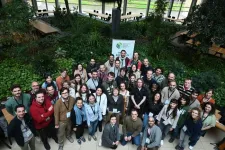(Press-News.org) A new study in JAMA Network Open led by researchers from the CUNY Graduate School of Public Health and Health Policy observed 28,322 park users across 54 neighborhood parks and found a clear association between park renovation and park use in low-income neighborhoods in New York City (NYC).
As the global trend toward urbanization continues, two thirds of the world’s population is predicted to live in cities by 2050. Amid the noise, stress, and crowding of city life, urban parks have the potential to provide opportunities for physical activity, mitigate heat and pollution, lower stress, and improve mental and social well-being, all of which can decrease the prevalence of chronic diseases.
Previous public health studies have established that parks in underserved areas with higher proportions of Black and Latino residents with low income historically receive less funding and have fewer physical activity resources than those in predominantly White and wealthier neighborhoods across the US. In addition, residents in lower- income areas have been shown to engage in less physical activity than those in higher-income areas. In NYC, despite the ubiquity of parks, disparities in park quality and use persist.
To address these disparities by ensuring parks equity, the NYC Department of Parks & Recreation (NYC Parks) launched the Community Parks Initiative (CPI) in 2014, a $318 million redesign and renovation of 67 neighborhood parks. Selected parks were historically underinvested, having received less than $250,000 in capital investment in the past 20 years. The selected sites were situated in densely populated and growing neighborhoods with higher-than-average concentrations of residents living in high poverty. Across CPI sites, the park renovations improved aesthetics, vegetation, shade, seating areas, accessibility, children’s play equipment, exercise and sports amenities, and community gathering spaces. Community engagement was integral to planning for the park renovations. NYC residents participated in community input sessions to provide insights into how they would like to use the parks and ideas about what types of amenities could be incorporated into the renovation.
As the CPI rolled out in waves, it provided a unique opportunity to examine the effects of park redesign and renovation on park use and physical activity on an unprecedented citywide scale. The current study evaluated the association of the CPI from baseline to 1 year post park renovation (or approximately 3 years post baseline) on changes in park use and level of physical activity in parks.
Thirty-three intervention parks were selected from the CPI program. Twenty-one control parks were selected based on alignment with CPI program criteria and matched sociodemographics.
Overall, the CPI was associated with a greater net number of park users at intervention parks over time. This was a result of both increased use of CPI parks and decreased use of control parks, with some differences by age and sex.
Among youths (defined as age 20 and below), park use remained steady over time in intervention parks while it decreased significantly in control parks. Among adults, park use increased significantly at intervention parks but remained unchanged at control parks.
There was a greater net number of both female and male park users at intervention vs. control parks over time, due to a marginal increase in female users at intervention parks and significant decreases of users of both sexes at control parks.
The CPI led to a net positive increase of users engaged in sitting or standing at intervention vs control parks over time. Sitting or standing increased significantly at intervention parks but did not change at control parks. Furthermore, there was a net positive number of users engaged in walking or vigorous physical activity at intervention vs control parks over time. Park users engaging in walking or vigorous physical activity did not change significantly at intervention parks but decreased significantly at control parks.
In this study, park redesign and renovation were associated with increased park use in low-income neighborhoods, offering a rare opportunity to evaluate initiatives on park use and park-based physical activity in NYC communities that are heavily Black and Latino. The large number of park sites and longitudinal design with matched controls are major strengths in this study. While the findings suggest a positive impact on park use, especially among adults, more research is needed for understanding park-related physical activity. This study may help inform future urban development and public health policies regarding public parks.
"We are thrilled to see the evidence highlighting what we already knew, that investing strategically in our local parks increases New Yorkers’ use of them. CPI is a cornerstone parks equity program that is fundamental to our agency’s work, and we recently announced 20 new sites that will go through renovation, as part of this program's expansion efforts," said NYC Parks Commissioner Sue Donoghue. “We extend our gratitude to the CUNY Graduate School of Public Health and Health Policy, and our partners, for developing research focused on the significance of enhancing public parks across the five boroughs. The investment in our local parks benefits all New Yorkers because they add critical spaces for wholesome recreation, fostering community cohesion, and connecting with nature.”
“Thanks to the CPI, this is one of the largest studies on how improving urban parks affects park use,” says senior author Distinguished Professor Terry Huang. “While we found a significant net increase in park users at intervention vs. control parks over time, the study also suggested that more efforts may be needed, such as culturally tailored programming, to promote physical activity in parks. Improving the physical environment is the first step; we now need to leverage it to also enhance the social environment to ultimately improve population wellbeing.”
About CUNY Graduate School of Public Health and Health Policy (CUNY SPH)
The mission of CUNY SPH is to promote and sustain healthier populations in New York City and around the world through excellence in education, research, and service in public health and by advocating for sound policy and practice to advance social justice and improve health outcomes for all.
END
$318 million New York City community parks initiative is associated with increased use of urban parks in low-income neighborhoods
2024-04-11
ELSE PRESS RELEASES FROM THIS DATE:
Trapped in the middle: billiards with memory
2024-04-11
Adding one simple rule to an idealized game of billiards leads to a wealth of intriguing mathematical questions, as well as applications in the physics of living organisms. This week, researchers from the University of Amsterdam, including two master students as first authors – have published a paper in Physical Review Letters about the fascinating dynamics of billiards with memory.
Billiards: a mathematical mystery
An idealized version of the game of billiards has fascinated mathematicians for decades. The basic ...
A new spin on organic shampoo makes it sudsier, longer lasting
2024-04-11
While there’s no regulation in the U.S. for what’s in organic shampoos, they tend to contain ingredients perceived as safe or environmentally friendly. However, these “clean” shampoos separate and spoil faster than those made with synthetic stabilizers and preservatives. Now, researchers in ACS Sustainable Chemistry & Engineering demonstrate that a simple process — spinning organic shampoo at high speeds — improved the final products’ shelf lives and ability to clean hair.
Natural emulsifiers, such as xanthan gum and cetyl alcohol, ...
Nanoscale movies shed light on one barrier to a clean energy future
2024-04-11
DURHAM, N.C. -- Left unchecked, corrosion can rust out cars and pipes, take down buildings and bridges, and eat away at our monuments.
Corrosion can also damage devices that could be key to a clean energy future. And now, Duke University researchers have captured extreme close-ups of that process in action.
“By studying how and why renewable energy devices break down over time, we might be able to extend their lifetime,” said chemistry professor and senior author Ivan Moreno-Hernandez.
In his lab at Duke sits a miniature version of one such device. Called an electrolyzer, ...
American College of Lifestyle Medicine announces first two medical schools to earn highest recognition and certification for lifestyle medicine curriculum
2024-04-11
The American College of Lifestyle Medicine (ACLM) has announced that the University of South Carolina School of Medicine Greenville (SOMG) and Loma Linda University School of Medicine (LLUSM) are the first to earn the highest recognition of a “Platinum Plus” certification designation for the significant level of undergraduate lifestyle medicine curricula within their programs.
The Platinum Plus is the highest tier of certification that a medical school can receive from ACLM and indicates the incorporation of at least 100 hours of evidence-based lifestyle medicine content within the curriculum. This level of lifestyle medicine ...
Avi Wigderson receives ACM A.M. Turing Award for groundbreaking insights on randomness
2024-04-11
ACM, the Association for Computing Machinery, today named Avi Wigderson as recipient of the 2023 ACM A.M. Turing Award for foundational contributions to the theory of computation, including reshaping our understanding of the role of randomness in computation, and for his decades of intellectual leadership in theoretical computer science.
Wigderson is the Herbert H. Maass Professor in the School of Mathematics at the Institute for Advanced Study in Princeton, New Jersey. He has been a leading figure in areas including computational complexity theory, algorithms and optimization, randomness and cryptography, parallel and distributed computation, combinatorics, and graph theory, as well as ...
NAWI awarded funding to continue to accelerate research and development for a secure water future
2024-04-11
– By Lauren Core
The National Alliance for Water Innovation (NAWI), which is led by the Department of Energy’s (DOE) Lawrence Berkeley National Laboratory (Berkeley Lab), has been extended for five more years with $75 million in funding from DOE. NAWI will continue its contributions to helping decarbonize the water and wastewater sectors through investments in technologies that enhance the efficient use of energy for water use, treatment, and distribution.
“Water and energy are interdependent – water is used to produce nearly every major energy source, and ...
2024 Research Fellowship Awards to support three exciting disease intervention research projects
2024-04-11
Systems Biology Ireland (SBI) at University College Dublin (UCD) and The Quantitative Biosciences Institute (QBI) at the University of California, San Francisco (UCSF), and) have announced the 2024 winners of the joint Research Fellowship Awards (RFAs).
The Research Fellowship Awards aim to support collaborative high quality and ground -breaking research proposals from QBI-UCSF and UCD in the areas of network biology and drug/drug target discovery.
The winning projects for 2024 are:
“Overcoming Resistance to HER2-Targeted Therapies in Breast Cancer,” ...
Laura Soucek receives an ERC Advanced Grant to maximize the clinical and preclinical use of the first viable MYC inhibitor
2024-04-11
Laura Soucek, an ICREA Research Professor, Director of VHIO’s Experimental Therapeutics Program, and Head of our Models of Cancer Therapies Group, has received a European Research Council (ERC) Advanced Grant to maximize the use of the first clinically viable MYC inhibitor.
This ERC funding program is amongst the EU’s most prestigious and competitive, providing leading senior researchers with the opportunity to pursue ambitious, curiosity-driven projects that could lead to major scientific breakthroughs. The new grants, worth in total nearly €652 million, are part of the EU’s Horizon Europe programme. ...
UMSOM researchers identify safety of a potential new treatment to manage complications from sickle cell disease
2024-04-11
A drug approved to treat pulmonary arterial hypertension may be effective at managing hypertension and end-organ damage in patients with sickle cell disease, according to a new study published in Lancet Haematology. An early phase randomized clinical trial involving 130 patients with sickle cell disease found that the drug, called riociguat, was found to be safe to use and well tolerated in these patients and significantly improved their blood pressure. Preliminary efficacy data suggested the medication might improve heart function.
An estimated 100,000 Americans ...
Advancing biodiversity data analysis at B-Cubed’s Hackathon
2024-04-11
B-Cubed’s Hackathon – “Hacking Biodiversity Data Cubes for Policy” – concluded successfully on 5 April in Brussels. The event marked a significant milestone in the use of data cubes for enhancing biodiversity data analysis and policy-making. Over four days, participants from diverse backgrounds collaborated to explore innovative solutions aimed at standardising and improving the accessibility of biodiversity data.
The event began with a foundational presentation on data cubes by Andrew Rodrigues ...





